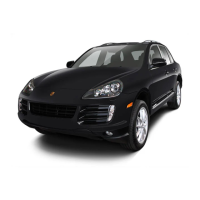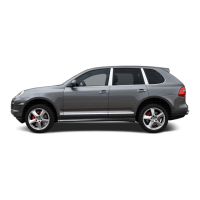Electrics
Page 9.5
The static cornering light, with a beam angle of approx. 30° with
respect to the direction of travel (controlled by the steering angle),
provides better illumination of the road in the direction of the steered
corner (e.g. when turning) when the vehicle is stationary or when travel-
ling at speed up to 80 mph (130 km/h).
The static cornering light is switched on if the following condi-
tions are met:
• Dipped beam “ON” (via light switch) or the light sensor detects the
need for lights “ON”.
• Steering angle a
on
=2°.
• Speed-dependent.
• Terminal 15 analog and terminal 15 via CAN signal.
The static cornering light is switched off if one of the following
conditions is met:
• Dipped beam “OFF”.
• Steering angle a
off
=< 2°.
• Terminal 15 as CAN signal “OFF”.
• Terminal 15 analog “OFF”.
• High beam “ON”.
Static cornering light control depends on the characteristics that were
defined during the development phase. The static cornering light is
switched on when there is a jump from 0 % to 30 % (U
eff jump
). The volt-
age is adjusted in a “ramp” from 30 % then to 100 % (U
eff jump
).
Essentially, a steeper “ramp” (see Phase 4) is used for increasing the
voltage. The voltage is reduced using a flatter “ramp” (see Phase 6).
The adjusting behaviour depends on the various signals:
• Steering angle
• Steering angle speed
• Vehicle speed
• Left/right direction indicator
• Reverse gear
Bi-Xenon headlights when turning (static corner-
ing light active).
1 - Voltage (U) eff in %
2 - Voltage (U) eff max
3- Voltage (U) eff jump
4 - Time (t) on – switch-on phase
5 - Time (t) – -holding phase
6 - Time (t) off – switch-off phase
7 - Time (t) in ms
8 - Switch-on condition met
9 - Switch-off condition met
Notes
When setting the direction indicator light,
the time “t
ON
” is reduced by a predefined
factor.
Bi-Xenon headlights during cornering (static and
dynamic cornering light active).

